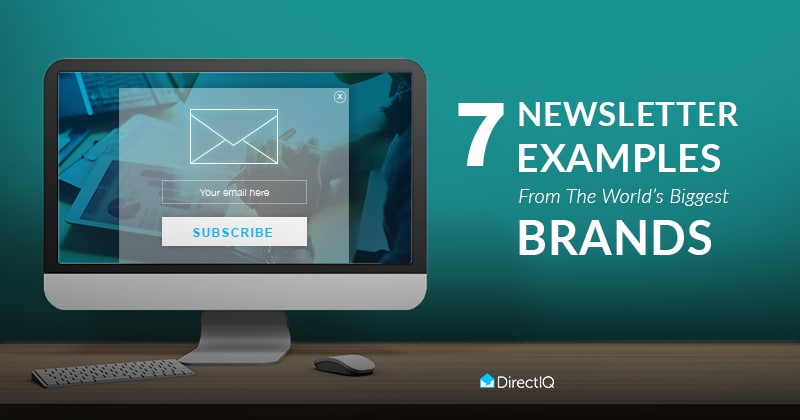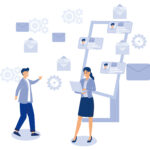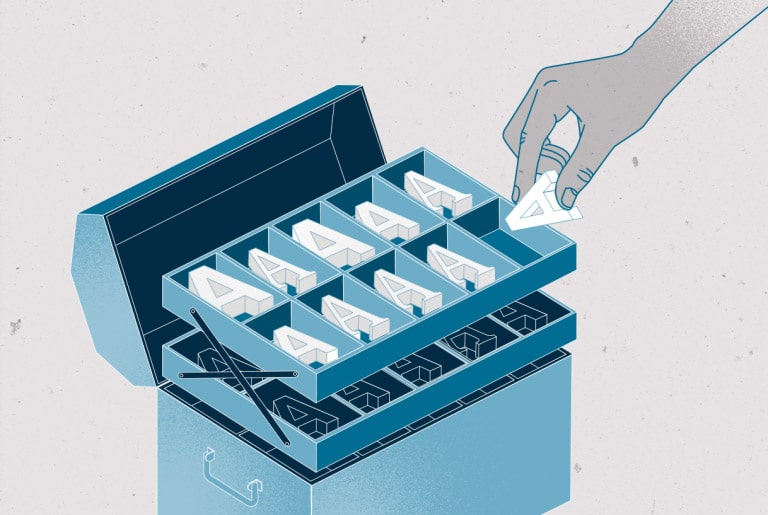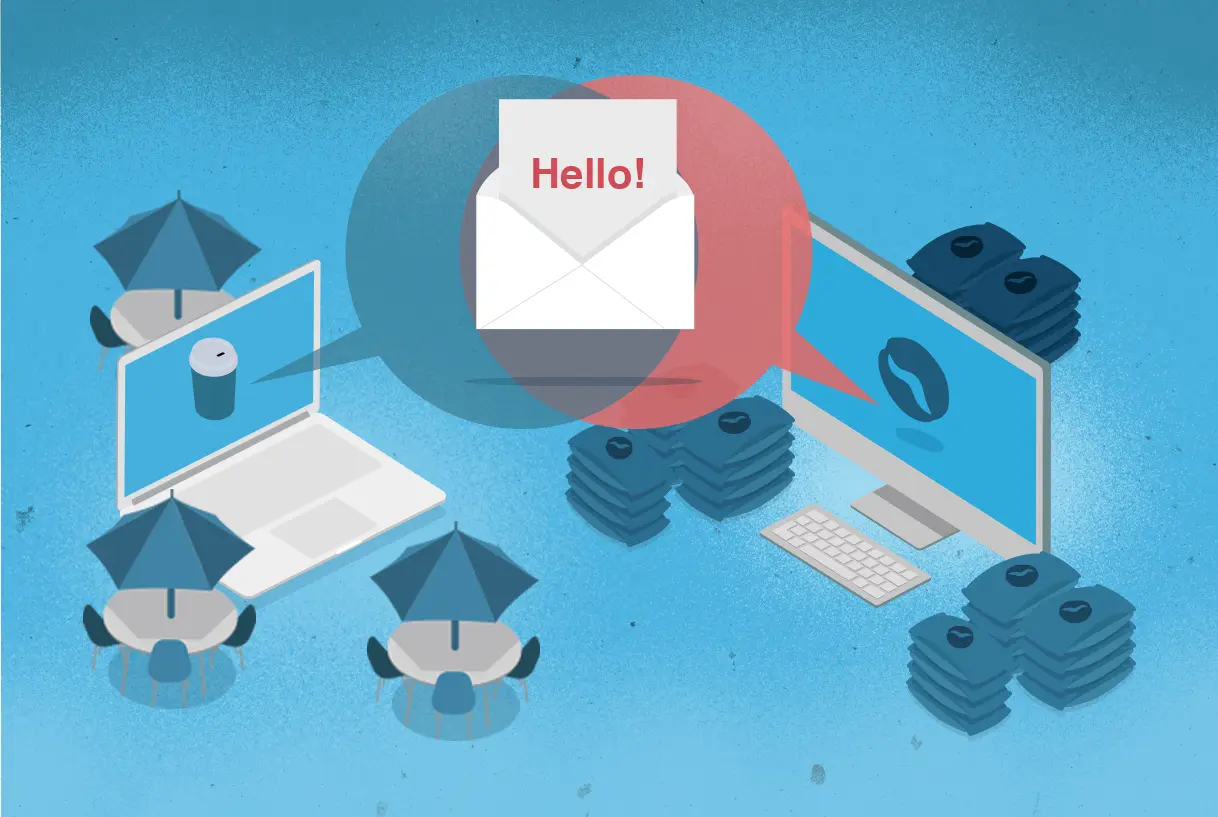7 Email Marketing Newsletter Examples
What are the best email marketing newsletter examples?
If you are looking for some email newsletter design examples, you’ve come to the right place.
In this guide, we will explore the best newsletter email examples from the world’s biggest brands.
Straight off the bat, here are a few key characteristics of effective email newsletters:
- Clear purpose
- Visually appealing
- Immediate value
- Well-structured
Can you imagine a marketing tool that has a return on investment (ROI) of $44 for every $1 spent?
It exists. It’s called email. Despite the torrents of spam that have bruised email marketing’s reputation, reports of its death have been greatly exaggerated. And of course we are deep diving into the best company newsletters examples of 7 of the world’s biggest brands.
Email Newsletter Design Examples (Why Do They Matter?)
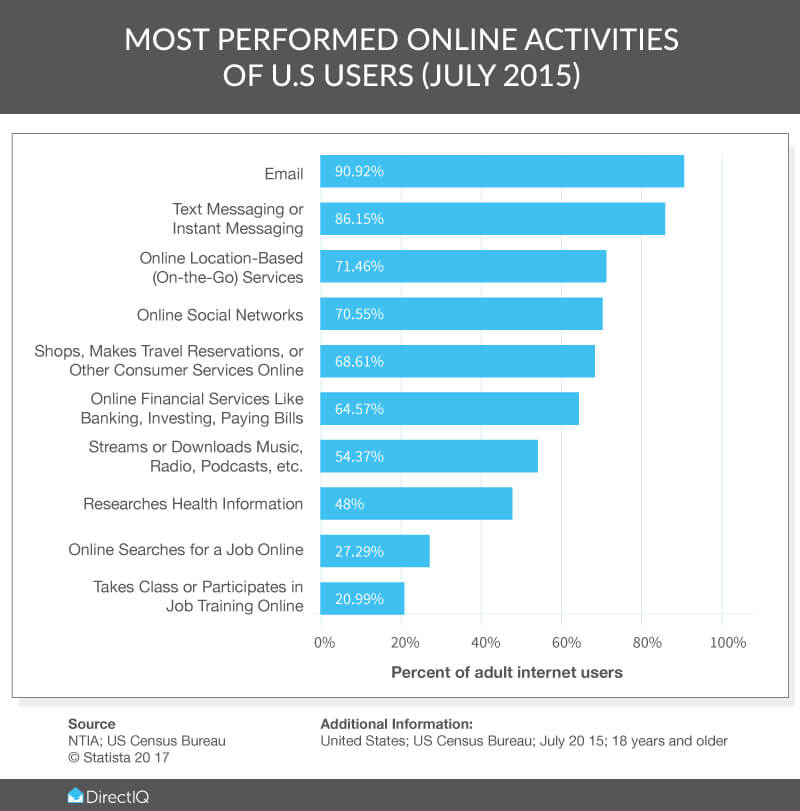
As this graph from Statista dated July 2015 shows, email is the most common online activity for US adults, underlining its huge marketing potential. No other platform allows businesses to communicate directly with customers so easily and effectively.
Given these compelling statistics, it comes as no surprise to see the world’s leading brand devote significant resources to developing powerful email marketing campaigns.
7 Email Newsletter Examples To Get Your Creative Juices Flowing
Here are seven innovative company email newsletter examples of powerful marketing techniques, illustrated with real-world company email newsletter samples:
1. Mercedes: Sign-up Forms and Segmentation
Before focusing on the design or content of a newsletter, you need permission from potential subscribers to send it to them in the first place. After you’ve cleared that all-important first hurdle, seize the opportunity to find out what type of content each individual customer wants to receive why not focusing on a few best practices too.
Collecting this information at the time of sign-up gives you the ability to create personalized content based on a subscriber’s specific areas of interest. Employing this strategy of segmentation will help ensure your email newsletters get opened, your subscribers remain engaged, and your unsubscribe rate stays low. With this example of a good newsletter, luxury automotive brand, Mercedes, teaches a master class in how to use a detailed sign-up form to find out what each individual subscriber wants to hear about via email:
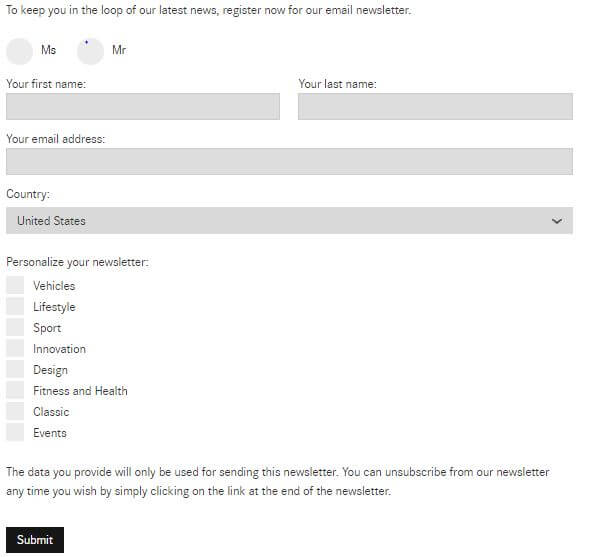
As you can see, there are numerous interests to choose from. Together with an assurance that customer data provided will only be used for sending newsletters. It gets even better.

Once you have clicked on the main options, a sub-list comes up with more specific categories, giving the subscriber complete control over what correspondence they have with Mercedes.I selected ?Vans.?And guess what?
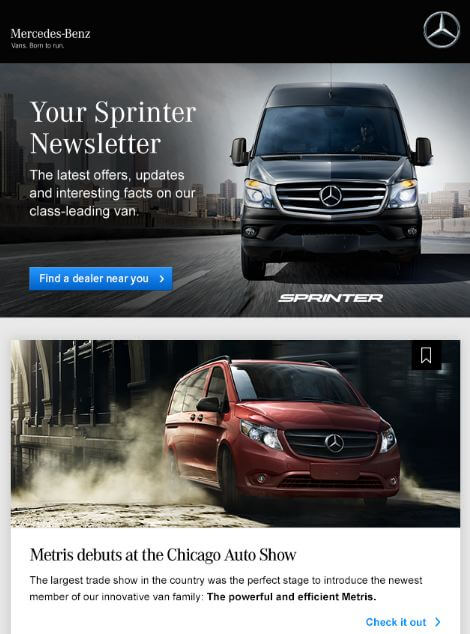
A few days later, I received this email, from Mercedes, about vans. This is just one example of how you can be creative with sign-up forms.
Segmenting your subscriber list to enable targeted campaigns can boost your open rates by 14.64% and CTR by 59.99% over non-segmented emails. At DirectIQ, we provide a tool that helps you create segmented email lists.
2. Apple: Branding
Email is the primary form of communication between businesses and their clients. Use each email as an opportunity to build your brand. Too many small and medium-sized businesses? (SMB) miss out on this. One survey suggests that just 7% of SMBs use email marketing to build their brands effectively.
Consistency across multiple platforms is an important factor in building a brand online. The design of the email should be similar to your website and recognizable to its users. This is something Apple, the world’s most valuable brand for the past five years, does extremely well. Having been at the leading edge of marketing in the 21st century, Apple has mastered the art of branded email:
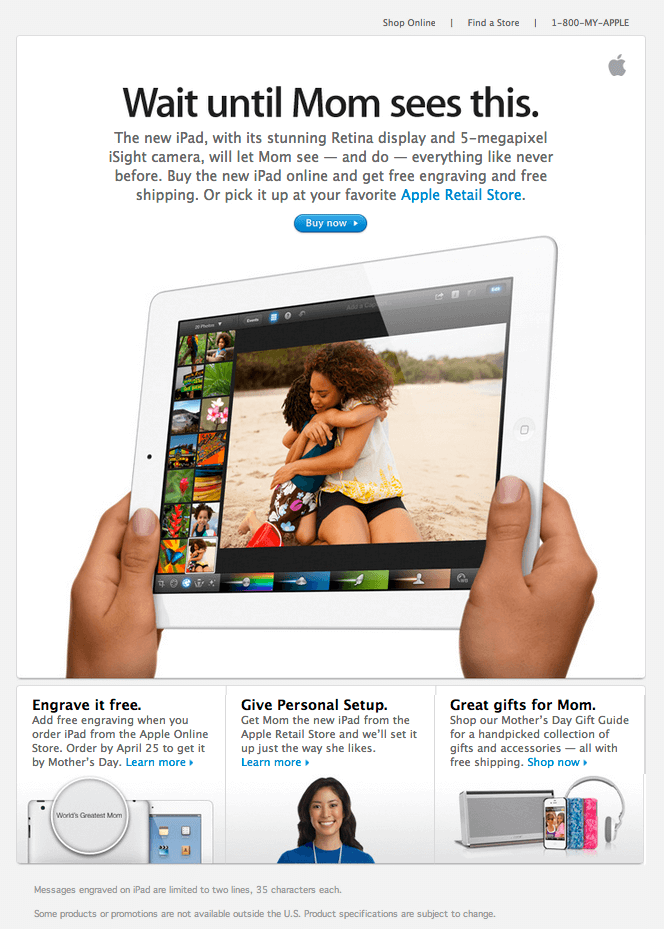
Take a look at the email. With little use of the logo or the name, you instinctively know this is from Apple. The image of the iPad helps but it is also down to the design, which is synonymous with the Apple brand. When you compare Apple’s newsletter to its website or their event newsletter examples for upcoming events, you will see plenty of consistencies in terms of design, color scheme, and layout.
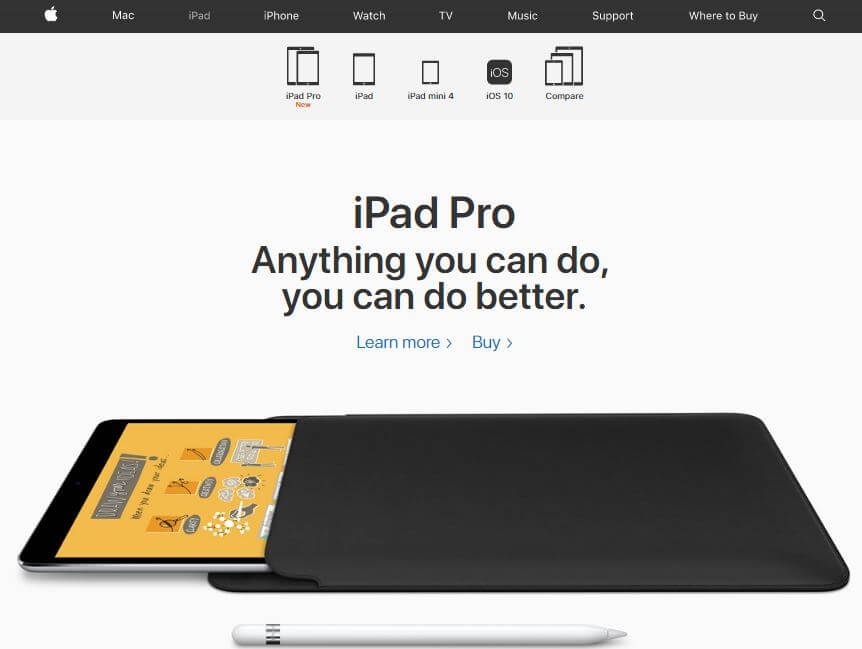
Additionally, the story element to the email helps to foster a sense of attachment to the brand. “Wait until Mom sees this” is a powerful statement and one that resonates with most of the younger generation on Mother’s Day.
There is no doubt the purpose of the email is to sell products but it is also simultaneously building the brand.
Even companies as enormous as Apple, never miss a chance to develop their brand. A valuable lesson to learn.
3. Disney: Clear and Concise Email Newsletters
You may be tempted to cram your newsletter with every single piece of news or information from your company. Resist the urge.
One of the keys to a successful email newsletter is getting your point across quickly and concisely. With the average person devoting just 11.1 seconds on average to reading an individual email, you simply don?t have much time to grab your subscriber’s attention.
Keep your content concise for two these reasons:
- The dreaded wall of text and overly long emails are a major turn off for recipients. Most subscribers will simply switch off.
- Keep it short, sweet, and engaging. Capture subscriber attention and entice them to click through to your website if they want to read more.
Tear down the ?Wall? by leaving as much white space as possible when formatting, so the email doesn?t feel cluttered. This is particularly important for customers viewing on mobile devices. The links need to surrounded by enough negative space to be easily clickable.As an icon of the entertainment industry, Walt Disney is one of America’s most enduring brands. Disney has several theme parks across the USA, Asia, and Europe, with 20.4m visitors at Magic Kingdom in 2016 alone.
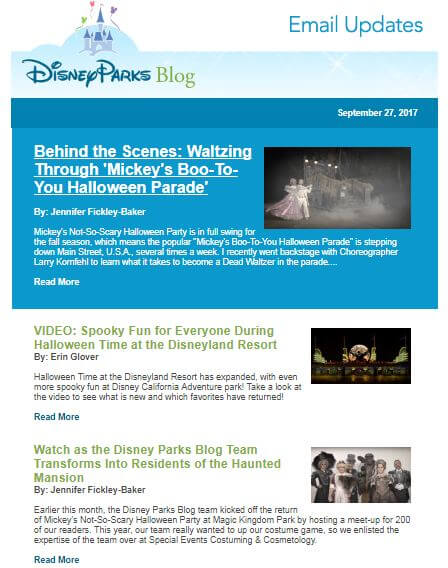
This newsletter from Disney Parks may not be as flamboyant as you might expect, but with a splash of color, it gives off a professional tone. The priority is to get its message across in clear and concise manner.
The headlines are themselves are clickable, making it easy for mobile users to click through to the site. Previews for the articles contain just enough information to tell you what they are about. To get the full story, you need to visit the website. This is exactly where Disney wants readers to go.
4. Cisco: Be Daring, Ditch Images
A healthy balance of images and text in the formatting is often critical in a successful consumer-focused email campaign. However, there are cases where a simple, text dominated email can be more effective.
For example, if you are a Business-to-Business (B2B) marketer then using either an excess, or the wrong kind, of images can make you look unprofessional.
This test carried out by Hubspot found that an HTML email with images had a 25% lower open rate than a well-designed plain text version. This despite respondents claiming, when surveyed, that they prefer receiving emails with images.
Cisco Systems, a world-leading IT company, takes the image free approach with its “Security Connections” newsletter.

While it is not plain text, the email is entirely focused on the content of the articles. The layout is professional and direct with informative copy, helping to reinforce the company’s reputation for competence and professionalism.
5. Amazon: Know Your Customers
Data is power. But many businesses, including the top brands, fall short when capturing the details of potential customers. It is suggested that up to 98% of website visitors leave without engaging on your site.
There are a number of effective ways to capture the email addresses of sales leads without scaring off potential customers or falling afoul of anti-spam legislation.
- Pop-up requests on your site: These are the pop-ups that ask for your email address when you either land on a page for the first time, scroll, or even just as you are about to leave the site. Pop-ups have become an increasingly familiar sight online: because they work. WPBeginner, a beginner’s guide for WordPress saw a 600% increase in subscribers after utilizing pop-ups.
- Content upgrades: These work well if you have an informational site or blog. Offer bonus content, for example, an e-book or downloadable PDF, in exchange for an email address.
- Special offers: This is a tried-and-true method. Promote a special offer on your site with the caveat visitors need to subscribe to get access.
These are just some of the many tactics you can deploy to boost your subscriber list. Once you have the email addresses, you can segment the lists and better tailor the emails to the interests of your customers. E-commerce king, Amazon, does this brilliantly. The company not only sends frequent emails promoting the latest products but also use subscriber buying history to select the items they are most likely to be interested in.
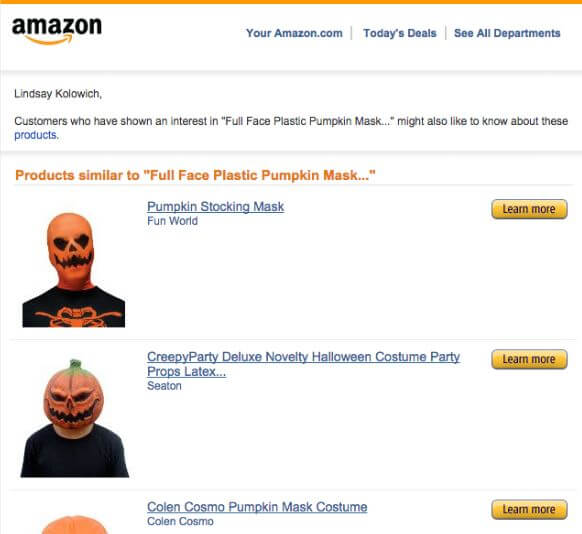
This is classic Amazon.You browse Halloween masks early in the week, and a few days later, Amazon sends you a list of items that you were viewing. Note, there are no prices, no indication of a special offer, or promotion. Just a list of items that you had recently shown an interest in. Amazon also utilizes this same technique for cross-selling. Buy an item on Amazon, and a few days or weeks later, you will receive an email showing similar or complementary or products. It’s a tactic that has proven incredibly effective, with Amazon once attributing 35% of the company’s revenue to cross-selling.
6. Netflix: Adding a Personal Touch
Personalization has been a buzzword of email marketing since its very beginnings. In the early days, personalizing emails was considered a difficult, time-consuming, and tedious exercise. Now, there is no excuse not to personalize.
As mentioned earlier, segmenting your email lists is easier than ever before, with most email service providers (ESPs), enabling you to fully customize your email campaigns.
According to Experian, personalized emails can improve click through rates by 27% and opens by 11%, with countless other studies making similar claims. Working in a way similar to Amazon, Netflix recommends new programs or movies for customers to watch based on their preferences and viewing history
.
As you can see, Netflix doesn’t overdo it with the personalization. Instead, it addresses the customer by his first name (Kyle). And then shows a brief description and image of a movie he might be interested in.
That’s it.
A simple, personal message can go a long way towards leading subscribers to click-through to your website and buy your products.
7. Google: A Clear Call to Action
The number one point of email marketing is to drive subscribers to your website. Each and every element of the layout should be designed with this goal in mind. It is the calls to action (CTAs) that will drive the most traffic. Your CTAs need to stand out from the rest of the content. You can do this by using contrasting colors, different fonts, or creating a box separate from the main copy.
Also, you should consider limiting the number of CTAs. Studies have shown that emails with one CTA have increased click through rates by 371% while boosting sales by 1617%
.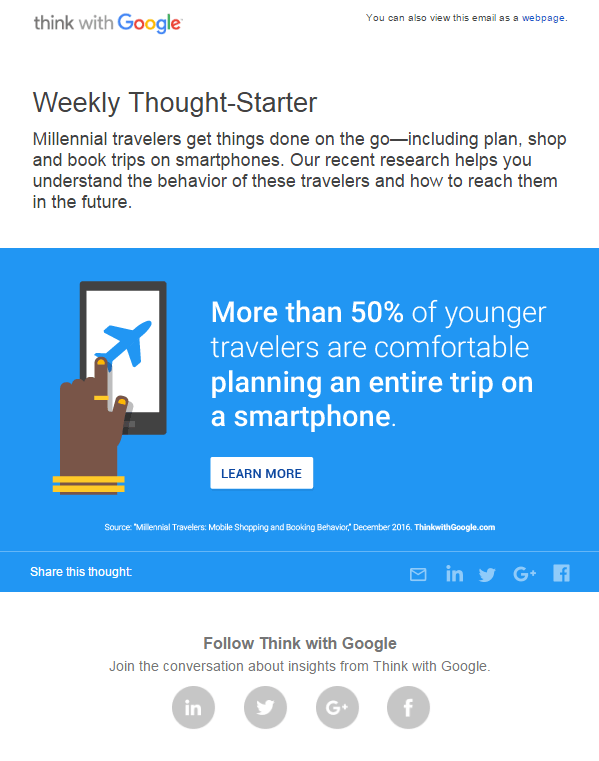
The newsletter from Think With Google is a great example of a focused and enticing CTA. The email itself has minimal content, just enough to entice the reader to learn more.
There are no bold colors, just a contrast between white and blue with an image of the phone on the side. The result is a clear, concise email leaving the reader in no doubt what the next step is: click-through to the Think With Google site.
Email Marketing Newsletter Examples (Key Elements)
These seven newsletter examples from some of the world’s leading brands all share the following elements:
- Clarity: The content and messages are clear. Subscribers will fully understand the purpose of the emails.
- Focus: There is a core focus on the email’s desired outcome, whether this is delivering the latest news, cross-selling products, or marketing events.
- Simplicity: The email layout is straightforward, single column, and mobile-friendly.
Newsletter Email Examples (Final Thoughts)
The days of cluttered emails, filled with unnecessary content, being effective are over. The world’s top brands understand that subscribers and customers want to have the ability to quickly scan emails and understand the message with ease.
There is no reason why your business cannot follow suit. It doesn’t require a huge budget or team of marketing geniuses to create revenue-boosting emails. Simply follow the guidelines above.
At DirectIQ, we provide affordable and smart email service solutions that make it easier for you to run effective and profitable campaigns.







